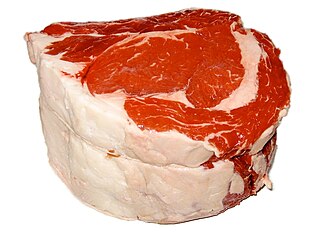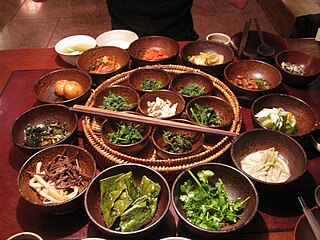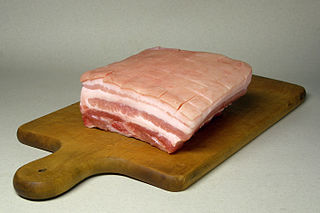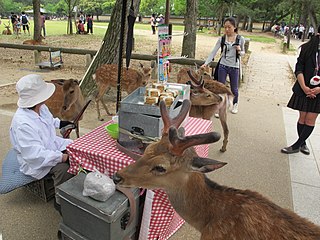
Meat is animal flesh that is eaten as food. Humans have hunted, farmed, and scavenged other animals for meat since prehistoric times. The establishment of settlements in the Neolithic Revolution allowed the domestication of animals such as chickens, sheep, rabbits, pigs, and cattle. This eventually led to their use in meat production on an industrial scale in slaughterhouses.

Beef is the culinary name for meat from cattle. Beef can be prepared in various ways; cuts are often used for steak, which can be cooked to varying degrees of doneness, while trimmings are often ground or minced, as found in most hamburgers. Beef contains protein, iron, and vitamin B12. Along with other kinds of red meat, high consumption is associated with an increased risk of colorectal cancer and coronary heart disease, especially when processed. Beef has a high environmental impact, being a primary driver of deforestation with the highest greenhouse gas emissions of any agricultural product.

Animal husbandry is the branch of agriculture concerned with animals that are raised for meat, fibre, milk, or other products. It includes day-to-day care, management, production, nutrition, selective breeding, and the raising of livestock. Husbandry has a long history, starting with the Neolithic Revolution when animals were first domesticated, from around 13,000 BC onwards, predating farming of the first crops. By the time of early civilisations such as ancient Egypt, cattle, sheep, goats, and pigs were being raised on farms.

Sukiyaki is a Japanese dish that is prepared and served in the nabemono style.
Venison originally meant the meat of a game animal but now refers primarily to the meat of deer. Venison can be used to refer to any part of the animal, so long as it is edible, including the internal organs. Venison, much like beef or pork, is categorized into specific cuts, including roast, sirloin, and ribs.

Offal, also called variety meats, pluck or organ meats, is the internal organs of a butchered animal. The word does not refer to a particular list of edible organs, and these lists of organs vary with culture and region, but usually exclude skeletal muscle. Offal may also refer to the by-products of milled grains, such as corn or wheat.

Lunch meats—also known as cold cuts, luncheon meats, cooked meats, sliced meats, cold meats, sandwich meats, delicatessens, and deli meats—are precooked or cured meats that are sliced and served cold or hot. They are typically served in sandwiches or on a tray. They can be purchased pre-sliced, usually in vacuum packs, or they can be sliced to order.

There are different systems of feeding cattle in animal husbandry. For pastured animals, grass is usually the forage that composes the majority of their diet. In turn, this grass-fed approach is known for producing meat with distinct flavor profiles. Cattle reared in feedlots are fed hay supplemented with grain, soy and other ingredients to increase the energy density of the feed. The debate is whether cattle should be raised on fodder primarily composed of grass or a concentrate. The issue is complicated by the political interests and confusion between labels such as "free range", "organic", or "natural". Cattle raised on a primarily foraged diet are termed grass-fed or pasture-raised; for example meat or milk may be called grass-fed beef or pasture-raised dairy. The term "pasture-raised" can lead to confusion with the term "free range", which does not describe exactly what the animals eat.

In gastronomy, red meat is commonly red when raw, in contrast to white meat, which is pale in color before cooking. In culinary terms, only flesh from mammals or fowl is classified as red or white. In nutritional science, red meat is defined as any meat that has more of the protein myoglobin than white meat. White meat is defined as non-dark meat from fish or chicken.

In culinary terms, white meat is meat which is pale in color before and after cooking. In traditional gastronomy, white meat also includes rabbit, the flesh of milk-fed young mammals, and sometimes pork. In ecotrophology and nutritional studies, white meat includes poultry and fish, but excludes all mammal flesh, which is considered red meat.
Some people do not eat various specific foods and beverages in conformity with various religious, cultural, legal or other societal prohibitions. Many of these prohibitions constitute taboos. Many food taboos and other prohibitions forbid the meat of a particular animal, including mammals, rodents, reptiles, amphibians, fish, molluscs, crustaceans and insects, which may relate to a disgust response being more often associated with meats than plant-based foods. Some prohibitions are specific to a particular part or excretion of an animal, while others forgo the consumption of plants or fungi.

Buddhist vegetarianism is the practice of vegetarianism by significant portions of Mahayana Buddhist monks and nuns and some Buddhists of other sects. In Buddhism, the views on vegetarianism vary between different schools of thought. The Mahayana schools generally recommend a vegetarian diet because they claimed Gautama Buddha set forth in some of the sutras that his followers must not eat the flesh of any sentient being.

Ractopamine is an animal feed additive used to promote leanness and increase food conversion efficiency in farmed animals in several countries, but banned in others. Pharmacologically, it is a phenol-based TAAR1 agonist and β adrenoreceptor agonist that stimulates β1 and β2 adrenergic receptors. It is most commonly administered to animals for meat production as ractopamine hydrochloride. It is the active ingredient in products marketed in the US as Paylean for swine, Optaflexx for cattle, and Topmax for turkeys. It was developed by Elanco Animal Health, a division of Eli Lilly and Company.

The environmental impacts of animal agriculture vary because of the wide variety of agricultural practices employed around the world. Despite this, all agricultural practices have been found to have a variety of effects on the environment to some extent. Animal agriculture, in particular meat production, can cause pollution, greenhouse gas emissions, biodiversity loss, disease, and significant consumption of land, food, and water. Meat is obtained through a variety of methods, including organic farming, free-range farming, intensive livestock production, and subsistence agriculture. The livestock sector also includes wool, egg and dairy production, the livestock used for tillage, and fish farming.

Pig farming or pork farming or hog farming is the raising and breeding of domestic pigs as livestock, and is a branch of animal husbandry. Pigs are farmed principally for food and skins.

The brain, like most other internal organs, or offal, can serve as nourishment. Brains used for nourishment include those of pigs, squirrels, rabbits, horses, cattle, monkeys, chickens, camels, fish, lamb, and goats. In many cultures, different types of brain are considered a delicacy.

Pork is the culinary name for the meat of the pig. It is the most commonly consumed meat worldwide, with evidence of pig husbandry dating back to 5000 BCE.

Pescetarianism is a dietary practice based on the consumption of fish and shellfish to the exclusion of land-based meats. The practise incorporates seafood into an otherwise vegetarian diet, and may or may not include other animal products such as eggs and dairy products. Approximately 3% of adults worldwide are pescetarian, according to 2017–2018 research conducted by data and analytics companies.

This article traces the history of cuisine of Japan. Foods and food preparation by the early Japanese Neolithic settlements can be pieced together from archaeological studies, and reveals paramount importance of rice and seafood since early times.

Japan has implemented several national animal welfare laws since 1973, but its protections for animals are considered weak by international standards. Animal activism and protection laws in Japan are mainly focused on the welfare of domesticated animals and farm animals.


















